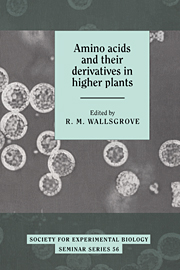Book contents
- Frontmatter
- Contents
- List of contributors
- Preface
- Glutamine synthetase in higher plants: molecular biology meets plant physiology
- Interactions of nitrogen and carbon metabolism: implications of PEP carboxylase and isocitrate dehydrogenase
- The genetics of aspartate derived amino acids in higher plants
- Oxidation of 1-aminocyclopropane-1-carboxylic acid (ACC) in the generation of ethylene by plants
- Regulation of carbon flow through the branched chain amino acid biosynthetic pathway
- Amino acid metabolism and protein deposition in the endosperm of wheat: synthesis of proline via ornithine
- The glycine decarboxylase complex in higher plant mitochondria: structure, function and biogenesis
- Glycine and serine synthesis in non-photosynthetic tissues
- Biogenesis of N-heterocydic amino acids by plants: mechanisms of biological significance
- Toxicity of non-protein amino acids from plants
- Processes involved in glutathione metabolism
- Betaines in higher plants – biosynthesis and role in stress metabolism
- Metabolism and function of polyamines during osmotically induced senescence in oat leaves and protoplasts
- Biosynthesis of cyanogenic glucosides. Elucidation of the pathway and characterization of the cytochromes P-450 involved
- The biosynthesis of glucosinolates in Brassicas
- Biochemical genetics of aliphatic glucosinolates in Brassica and Arabidopsis
- Index
The genetics of aspartate derived amino acids in higher plants
Published online by Cambridge University Press: 09 April 2010
- Frontmatter
- Contents
- List of contributors
- Preface
- Glutamine synthetase in higher plants: molecular biology meets plant physiology
- Interactions of nitrogen and carbon metabolism: implications of PEP carboxylase and isocitrate dehydrogenase
- The genetics of aspartate derived amino acids in higher plants
- Oxidation of 1-aminocyclopropane-1-carboxylic acid (ACC) in the generation of ethylene by plants
- Regulation of carbon flow through the branched chain amino acid biosynthetic pathway
- Amino acid metabolism and protein deposition in the endosperm of wheat: synthesis of proline via ornithine
- The glycine decarboxylase complex in higher plant mitochondria: structure, function and biogenesis
- Glycine and serine synthesis in non-photosynthetic tissues
- Biogenesis of N-heterocydic amino acids by plants: mechanisms of biological significance
- Toxicity of non-protein amino acids from plants
- Processes involved in glutathione metabolism
- Betaines in higher plants – biosynthesis and role in stress metabolism
- Metabolism and function of polyamines during osmotically induced senescence in oat leaves and protoplasts
- Biosynthesis of cyanogenic glucosides. Elucidation of the pathway and characterization of the cytochromes P-450 involved
- The biosynthesis of glucosinolates in Brassicas
- Biochemical genetics of aliphatic glucosinolates in Brassica and Arabidopsis
- Index
Summary
Introduction
Although the central role of amino acid biosynthesis in plant metabolism and development is evident, progress in the understanding of the molecular mechanisms by which such pathways are regulated is only recent. To elucidate the genetic regulation of a pathway, mutants have proved to be invaluable in the analysis of microbial systems. The same is true for plants, but again there are only a few pathways for which mutants with defective or altered essential functions are available. However, the improvements in plant mutant isolation at cell and whole plant levels, and in molecular biology have now provided mutants affected in amino acid metabolism as well as amino acid biosynthetic genes or cDNAs (for a review, see Last, 1992).
The branched biosynthetic pathway of aspartate-derived amino acids (lysine, methionine, threonine) and the related pathway leading to isoleucine, valine and leucine have received much interest for various reasons. First, it gives rise to essential amino acids which, if poorly represented as lysine in cereals and methionine in legumes, limit the nutritional quality of crop plants as diet for human beings and monogastric animals. Secondly, three classes of potent herbicides (sulphonylureas, imidazolinones and triazolopyrimidin) kill plants through the inhibition of acetolactate synthase, an enzyme common to the isoleucine and valine pathways. Key regulatory enzymes of the aspartate-derived amino acid biosynthesis would also be suitable targets for efficient herbicides while little affecting the environment.
- Type
- Chapter
- Information
- Amino Acids and their Derivatives in Higher Plants , pp. 29 - 50Publisher: Cambridge University PressPrint publication year: 1995
- 1
- Cited by



